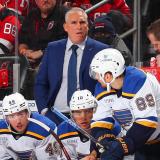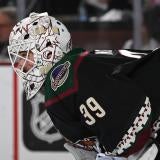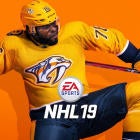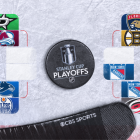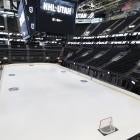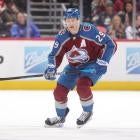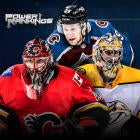EA Sports' latest installment of its popular NHL series, "NHL 19," releases Friday. We've been playing it for about a week, so here are some takeaways from our early access.
What's good?
The Skating: Often times when a game claims that it has "overhauled" a certain dynamic of gameplay, the product under-delivers. That's not the case with 'NHL 19'. The updated skating system in this year's edition is the most noticeable new feature, and it brings a massive upgrade to gameplay.
Whereas last year's game brought skating that often felt clunky and frustrating, the skating in 'NHL 19' is most fluid and authentic than it's ever been in franchise history. It makes a world of difference when it comes to gameplay; players respond to motion commands quickly and in lifelike fashion. It helps bridge a gap between the fast, arcade style of gameplay in older NHL games and the more realistic experience that the game has been trying to deliver in recent years.
Also, the new skating system seems to put more emphasis on individual player attributes. In last year's game, it felt like there wasn't enough of a gap between player speeds. Speedy forwards could often get caught by cement-footed defensemen on rushes down the ice, and it was incredibly frustrating. This year, players who are faster and have greater acceleration have the ability to blow by slower players, leading to deserved scoring chances.
I don't know if this necessarily falls in line with the skating system, but the hitting in this year's game is also much improved. Skating and collisions seem to take weight, momentum, velocity, and player skill into account on the ice. This results in more realistic, satisfying sequences on the ice.
Depth of Game Modes: One of the coolest additions to this year's game is "World of Chel." Although I still cringe at the name, the new hub brings a bit of freshness to game modes in NHL 19. To enter World of Chel, you create a playable character that can be dropped into a variety of game modes -- including a very unspectacular offline Pro-Am mode, the popular EASHL online team play mode, the arcade-style NHL Threes mode that was introduced last year, and an awesome new mode called NHL Ones.
Playing Ones -- a 1v1v1 free-for-all where you race to outscore your other two opponents on the ice -- may bring experienced NHL gamers back to the days of NHL 2006 and the very similar "Free For All" game mode, though this latest version doesn't allow for oversized player heads. (Unfortunately.) Either way, it's very welcome addition to NHL's collection of game modes, as it's an addictive and fun way to hone your one-on-one game.
Along with World of Chel comes pond hockey venues and a massive upgrade in the player customization department. Users can outfit their playable characters in a wide variety of clothing and equipment, ranging from wacky jackets, sweatshirts and pants to NHL team-branded merchandise and jerseys. You'll rarely see two online characters take to the ice in the same loadout.
The "World of Chel" seems like NHL's response to NBA 2K's popular Blacktop mode, and it's a pretty decent first effort. The customization and breadth of drop-in options brings a bit more depth to the gameplay options and that's a good thing.
For offline players, Franchise Mode appears to be largely similar to the product rolled out last year, but with one exception. EA Sports has overhauled the mode's scouting system from top-to-bottom. When you take over a franchise, you're tasked with assembling a team of 20 scouts that will evaluate both pro and amateur talent, meaning the quality of your scouting will likely affect the quality of drafting, trading, and free agency decisions. I didn't get too much of a chance to play around with it -- at least not over a long period of time -- and it's certainly not the sexiest upgrade, but it's something that may be valued by those who invest enough time into franchise mode to play across multiple seasons.
Miscellaneous:
- Group celebrations: It's such a small thing, but the post-goal player celebrations are a bit smoother this year. Plus, they now have group goal celebrations where the entire group of guys on the ice get together and celebrate with the goal scorer. NHL has often overlooked some of the smaller details that can help close the gap between video game and reality, so it's nice when they make strides in that department.
- Goaltender play: Goalie play has been the source of infinite headaches and broken controllers over the past few years. It often seems like a never-ending seesaw between mind-blowingly awful plays in net and just absurdly ridiculous saves. Honestly, it's been infuriating. And while goalie play is certainly not perfect in NHL 19, it's better. No controllers were harmed in the first week of playing.
- Power plays: If you played NHL 18 offline, one of the more frustrating parts of playing against the computer was that they almost never committed penalties. This meant that you rarely had a chance to flex your offensive muscles on the power play. That has been tweaked this year and you'll typically get a handful of man-advantage opportunities per game.
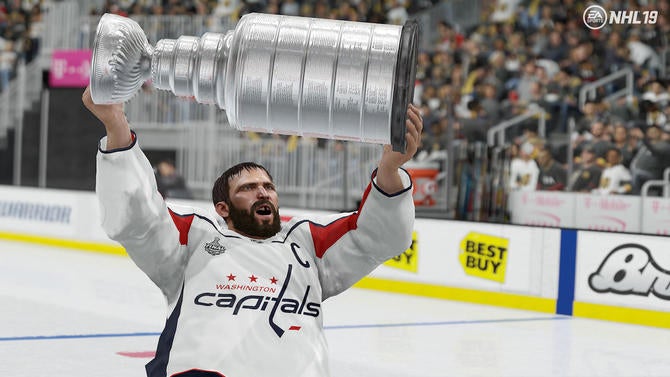
What's not-so-good?
Visuals/Presentation: While NHL has lagged behind a lot of other sports games in the graphics department for a number of years running, it seemed to make some efforts to bridge that gap in recent years. If they attempted to do that this year, it's not very noticeable. That's not to say the visual aspect of NHL 19 is awful, it just isn't much better than last year. Like, at all.
There are still way too many player faces that look nothing like their real-life counterparts, including some pretty significant players. Even some of the non-generic faces need tweaking.
And just as the graphics haven't changed much, neither has the game's presentation. If you were to jump into a game of NHL 19 and just watch the action unfold, there's not a lot to tell it apart from NHL 18. We still have the same commentary trio of Doc Emrick, Eddie Olczyk and Ray Ferraro and a very familiar slate of nonsensical dialogue. Most of the intros, cut scenes, replay formats, and other presentation aspects are the same. Presentation was already stale last year...now it's starting to get moldy.
It seems like most of the NHL development team's efforts went into improving gameplay and game modes rather than the visuals/presentation, and the lack the lack of progress aesthetically is a bit easier to swallow because of how much more fun the game is to actually play.
Let's break it down this way: If NHL 18 and NHL 19 were cars, they'd both have the same, relatively unassuming base body model. Let's call it a Toyota Corolla. But while they look the same from the outside, the NHL 19 Corolla is supercharged under the hood. It's still a Corolla, meaning it's not going to turn many heads on the street, but it's a whole lot more fun to drive. (This review is not sponsored by Toyota, but if they want to send me a free Corolla I will not object.)
In any case, it seems it might be fair to expect a presentation overhaul next year. Eddie Olczyk already confirmed earlier this year that he's no longer doing commentary for the game beyond this year.
Poke Checking: Gamers who played the NHL 19 Beta know what I'm talking about here. The poke checking function in the Beta was infuriating, as it would lead to a tripping call about one-third of the times you used it. It's not quite as terrible in the actual game, but it's still pretty sensitive.
Now, I don't necessarily think that's such a bad thing considering how many online gamers were poke check button-smashers in prior years. In NHL 19, you're forced to really contemplate whether you can/should attempt to poke check an opponent to try to force the puck off his/her stick. If you make the wrong call (and you will, quite often) you're going to head to the box while your opponent heads to the power play. It makes defense a little more challenging and frustrating, which could turn some gamers off, but it may just be a case of getting acclimated to the new style of play and using the poke in the right situations.
In any case, get ready to hear plenty of complaints about it.
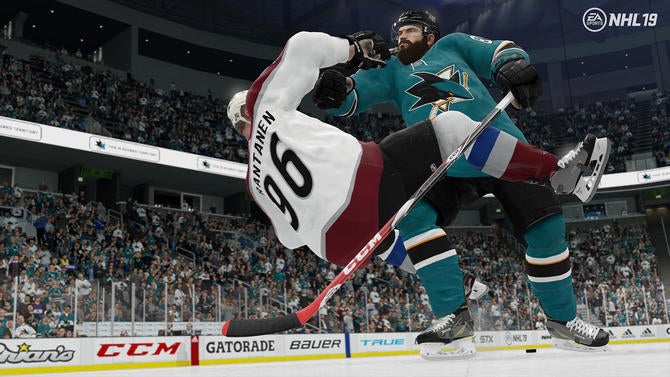
Be-A-Pro: It's still in the game, but it remains pretty much untouched. While other sports games are gravitating towards cinematic, story-driven player career modes, the NHL version has gathered dust. It'd be nice to have a deeper, more immersive experience that allows gamers to insert themselves into the skates of an NHL player. (Franchise mode could also use more immersive elements that help gamers feel like they're actually behind the GM desk, running their favorite team.)
Statistical depth: A big part of playing through a franchise mode or online league (like EASHL) is seeing what kind of numbers you can put up with your player(s)/team. Unfortunately, NHL 19 doesn't really cater to the numbers crowd. There aren't many analytical tools incorporated into the game beyond just basic ratings and stats.
I know a lot of gamers aren't going to be particularly interested in monitoring their Corsi and other advanced analytics because it's a video game, and only a real nerd would want to analyze their video game performance with a deep dive into charts and graphs. Do we really need the incorporation of advanced analytics for maximum enjoyment of a hockey video game? Probably not. But there might be a place for its inclusion. The NHL series aims to be a simulation, and it's inarguable that there's a growing emphasis on analytics within the hockey community.
Incorporating more evaluation methods beyond just classic stats (points, shots, hits, time of possession, etc.) could be a good way to help introduce analytics to some gamers and educate them on their value to the sport. Traditionalists can (and probably will just ignore the "fancy stats," but making them available to those with interest might be cool. MLB The Show has included advanced stats for a number of years now and I've seen very few baseball fans complain about it being available to them.







